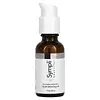What's inside
What's inside
 Key Ingredients
Key Ingredients

 Benefits
Benefits

 Concerns
Concerns

No concerns
 Ingredients Side-by-side
Ingredients Side-by-side

Ricinus Communis Seed Oil
MaskingPrunus Armeniaca Kernel Oil
MaskingPolysorbate 80
EmulsifyingSimmondsia Chinensis Seed Oil
EmollientPersea Gratissima Oil
Skin ConditioningRosa Canina Seed Oil
EmollientSclerocarya Birrea Seed Oil
HumectantArgania Spinosa Kernel Oil
EmollientPrunus Amygdalus Dulcis Oil
Skin ConditioningCitrus Aurantium Dulcis Oil
MaskingPolyglyceryl-4 Oleate
EmulsifyingTriticum Vulgare Germ Oil
EmollientTocopheryl Acetate
AntioxidantTocopherol
AntioxidantRicinus Communis Seed Oil, Prunus Armeniaca Kernel Oil, Polysorbate 80, Simmondsia Chinensis Seed Oil, Persea Gratissima Oil, Rosa Canina Seed Oil, Sclerocarya Birrea Seed Oil, Argania Spinosa Kernel Oil, Prunus Amygdalus Dulcis Oil, Citrus Aurantium Dulcis Oil, Polyglyceryl-4 Oleate, Triticum Vulgare Germ Oil, Tocopheryl Acetate, Tocopherol
Ingredients Explained
These ingredients are found in both products.
Ingredients higher up in an ingredient list are typically present in a larger amount.
You may know this ingredient as argan oil. Argan Oil has antioxidant, hydrating, and soothing properties.
Studies have shown argan oil can help fight again radical damage from the sun. This makes it effective at preventing hyperpigmentation.
Large amounts of vitamin E found in argan oil helps the skin retain water. Argan oil also contains fatty acids such as linoleic acid, oleic acid, and palmitic acid. It is also a good source of lipids.
Another benefit of argan oil is skin-soothing. It can help reduce inflammation-related skin symptoms.
Argan Oil is effective at regulating sebum production in pores. This can make it effective at treating hormonal acne.
Traditionally, argan oil was used for its antibacterial and antifungal properties. However, argan oil contains fatty acids that may make it not fungal-acne safe.
Argan Trees are native to Morocco.
Learn more about Argania Spinosa Kernel OilRosa Canina Seed Oil comes from the seeds of the dog-rose plant. It is an emollient.
Emollients help hydrate your skin by trapping moisture in. They create a thin film on the skin to prevent moisture from escaping.
Rosa Canina Seed Oil contains phenolic compounds, carotenoids, Vitamin C, linoleic acid, and other fatty acids.
Due to the fatty acid content, this ingredient may not be fungal-acne safe.
Learn more about Rosa Canina Seed OilThis oil comes from the seeds of the desert shrub called Jojoba. It is more commonly known as jojoba oil, a non-comedogenic oil.
Jojoba oil does not contain fragrance and has many fatty-acids, making it a great soothing ingredient.
It also contains Vitamin E, a great moisturizing ingredient. Vitamin E is also an antioxidant and protects your skin against oxidative damage.
This ingredient humectant properties, meaning it helps draw moisture from the air. This helps keep your skin hydrated.
While jojoba has antibacterial properties, it is only able to kill some strains of bacteria.
Studies also show it helps in wound healing. In fact, Indigenous cultures have used jojoba as a moisturizer and to help treat burns for centuries.
Fun fact: Jojoba oil similar to natural human skin sebum, so it has a great effect on dry skin. It is also promising with helping to regulate sebum production.
Due to its fatty acid content, Jojoba oil may not be fungal acne safe. We recommend speaking with a professional if you have any concerns.
Learn more about Simmondsia Chinensis Seed OilTocopherol (also known as Vitamin E) is a common antioxidant used to help protect the skin from free-radicals and strengthen the skin barrier. It's also fat soluble - this means our skin is great at absorbing it.
Vitamin E also helps keep your natural skin lipids healthy. Your lipid skin barrier naturally consists of lipids, ceramides, and fatty acids. Vitamin E offers extra protection for your skin’s lipid barrier, keeping your skin healthy and nourished.
Another benefit is a bit of UV protection. Vitamin E helps reduce the damage caused by UVB rays. (It should not replace your sunscreen). Combining it with Vitamin C can decrease sunburned cells and hyperpigmentation after UV exposure.
You might have noticed Vitamin E + C often paired together. This is because it is great at stabilizing Vitamin C. Using the two together helps increase the effectiveness of both ingredients.
There are often claims that Vitamin E can reduce/prevent scarring, but these claims haven't been confirmed by scientific research.
Learn more about Tocopherol